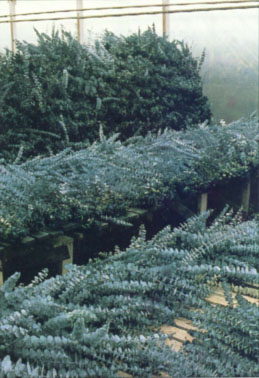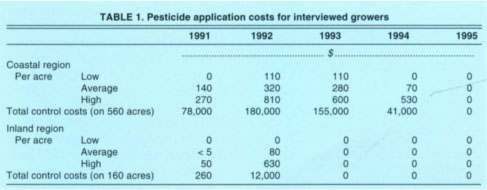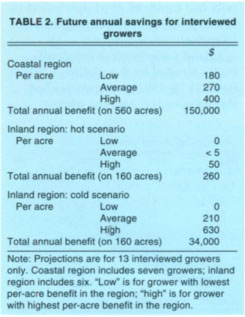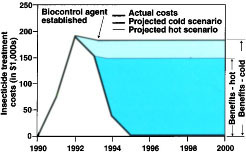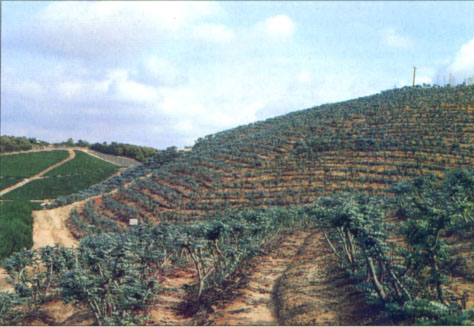All Issues
Biological control of the blue gum psyllid proves economically beneficial
Publication Information
California Agriculture 52(1):35-40. https://doi.org/10.3733/ca.v052n01p35
Published January 01, 1998
PDF | Citation | Permissions
Abstract
In 1992 a parasitoid native to Australia was introduced into California in a biological control program directed against the blue gum psyllid from Australia. Interviews with baby blue gum eucalyptus growers indicate that this program has had a benefit-cost ratio ranging from at least 9:1 to 24:1, based solely on the reduction of insecticide treatments. Additional economic benefits, including greater foliage yield, possible reduced environmental and health effects, and avoided pesticide resistance, were not calculated, but would further increase this ratio.
Full text
Since 1889, when the introduction of the vedalia beetle and a parasitic fly from Australia saved the citrus industry in California, classical biological control (the importation of the natural enemies of introduced pests) has been very important to agriculture in this state. Although the biological success of many of these programs has been well documented, researchers are often reluctant to spend additional funds to quantify the economic benefits. Economic analyses that compare a program's effectiveness with other pest management strategies can highlight the financial rewards associated with successful biocontrol programs and thus educate the agricultural community about lower-cost pest management optics.
Nursery and greenhouse crops, including ornamentals, represent a sizable share of California agriculture. In 1996, sales of $2.3 billion represented about 10% of all agricultural product sales in the state. At the county level, These crops can be even more important. In San Diego County, Nursery products and flower crops generated $643 million in 1995,61% of total agricultural sales.
Silver-leaved mountain gum or baby blue gum, Eucalyptus pulverulenta Sims, is an ornamental crop grown for foliage. Some growers sell it fresh: others dye the foliage and sell it in preserved floriculture markets. Although the tree is native to Australia, it has been grown commercially for at least 30 to 40 years in California, primarily in the costal belt from San Diego County north to Sonoma County, with additional inland acreage in Riverside County. There is no other significant commercial production of baby blue gum elsewhere in the United States, although some is grown in Mexico, Australia and Europe. Ornamental eucalyptus is often planted in plots of less than 5 acres, although some major nurseries grow close to 200 acres. Through 1990, this crop was highly profitable and virtually pest free, requiring only occasional treatments for aphids or snails.
The blue gum psyllid, Ctenarytaina eucalypti (Maskell) (Homoptera: Aphalaridae), native to Australia, was first reported in California in Monterey county in January 1991, and by summer it had spread to Southern California. Within months, psyllid populations in the coastal regions reached extremely high levels, resulting in blemished baby blue gum foliage that often could not meet the market's high cosmetic standards. Growers responded with increasingly frequent insecticide applications in 1991 and 1992.
Insecticide treatments proved to be expensive and unreliable. In San Diego County, where much of the baby blue gum is grown on extremely steep hillsides, many field were not accessible to ground rigs, and could only be sprayed by helicopter. Growers also often found that aerial applications on previously unsprayed fields met with complaints from neighboring homeowners. Most growers found that psyllid populations rebounded soon after treatment, necessitating up to 10 applications per season.
Processing eucalyptus shoots for market. Insecticide sprays were expensive and unreliable for protecting the ornamental crop from blue gum psyllid.
In August 1991, in consultation with UC Cooperative Extension farm advisors, about 30 ornamental eucalyptus growers funded the Eucalyptus Growers Committee to investigate new strategies to combat the psyllid. Because farm advisors had no prior experience with this pest, the committee sponsored pesticide effectiveness trails in September 1991 in San Diego County. Initial results promised little or no control.
In search of a long-term solution, the committee also funded a classical biological control program. At their request, UC Berkeley entomologist Donald Dahlsten conducted a search for natural enemies of the psyllid in Australia and New Zealand in late 1991 and early 1992, and shipped back a parasitoid, Psyllaephagus pilosus Noyes (Hymenoptera: Encyrtidae), which attacks only C. eucalypti. After its release in California in late 1992, this parasitoid spread rapidly throughout the ornamental eucalyptus-growing region. Reductions in psyllid populations were immediate and dramatic, and insecticide treatments for this pest virtually ceased by 1995.
This successful program presents a good opportunity for economic analysis. Only one pest and one natural enemy species are present, and the results of both introductions are clearly discernible. Although the analysis is complicated by a number of factors, substantial benefits due to the parasitoid introduction are measurable. This study is a joint effort between agricultural economists and the entomologists who conducted the original biological control program against the psyllid.
Methodological challenges
Our economic analysis is complicated by four methodological challenges. First, published data are not available on the number of ornamental eucalyptus growers, the total acreage of ornamental eucalyptus or the volume and costs of pesticides applied to the crop. Therefore we were forced to rely on empirical estimates by growers and farm advisors. For example, estimates of total California baby blue gum acreage at the time of the psyllid outbreak vary from 1,000 to 3,000 acres (the true total is probably closer to the lower figure). Additionally, the lack of a comprehensive list of growers makes it difficult to select a random sample of growers for interviews and prevents a proper extrapolation to describe the entire state. For this reason, we only report data for the growers whom we interviewed. These growers cultivated roughly 600 to 700 acres of ornamental eucalyptus, and thus represent at least 20%, and possibly 50% to 60%, of the total acreage.
The second challenge relates to the shifts in price and acreage over time and the possible relationship between the psyllid damage and these shifts. Many in the industry reported that acreage quickly increased in the 1980s in response to the strong market for the product. This led to a decline in prices, which coincided with the introduction of the psyllid. These two factors led to a decrease in profitability and acreage in the early 1990s as many growers replanted with other crops. In the mid-1990s prices rose slightly as psyllid treatment costs declined, and acreage again increased. However, our data is not sufficient to determine what share of this price increase is directly attributable to the lessened impact of the psyllid, and thus is not addressed in our analysis.
The third challenge relates to the fact that P. pilosus provided control so soon after the psyllid was detected. This rapid success makes our analysis more difficult, because control costs were in flux in the short window of time before the parasitoid was established. The first years of insecticide applications are not necessarily representative of long-term trends if the biological control had been delayed. One possibility is that increasingly sophisticated application methods could have led to a decline in control costs. It is also possible that, with extended exposure, psyllid populations would have developed resistance to some or all of the insecticides that were initially used, leading to an increase in control costs. To account for these and other potential outcomes, we constructed scenarios based on interviews with growers, in which we assessed a range of the most likely future developments.
The final challenge relates to the difficulty of assessing the possible environmental and other social benefits of the biological control program. After the parasitoid became established, it is possible that environmental benefits began to accrue in the form of decreased runoff of insecticides. Health benefits may also have begun to accrue to farmworkers, neighbors and consumers. However, these indirect costs are very difficult quantify. Thus we do not account for them in our analysis, although they may ultimately be as important as the benefits that we do analyze.
Grower interviews
To identify baby blue gum growers, we consulted with farm advisors in Monterey, Santa Cruz, San Luis Obispo and San Diego counties, where most of the ornamental eucalyptus in California is grown. We then conducted personal interviews with 13 growers (most of whom were members of the Eucalyptus Growers Committee) and supplemented these interviews with follow-up phone calls. We queried growers about the number of acres planted in eucalyptus and about the cost and number of treatments during three time periods: (1) before the psyllid; (2) after the psyllid was established but before the parasitoid was released; and (3) after the parasitoid was established. We also asked growers to outline their expected activities and costs if the biocontrol program had not been successful.
Actual costs
In our calculation, we consider the actual pesticide application costs incurred by baby blue gum growers due to the psyllid. These costs include labor, chemicals and additional equipment purchased specifically for psyllid control.
There are many other costs that we do not consider. Heavy psyllid infestations resulted in foliage that was blemished by black spots, honeydew and sooty mold, and therefore many growers could not sell their entire product during the peak of the infestation. Some growers also reported foliage damage from the infestation. Some growers also reported foliage damage from the insecticides them selves, which further affected the volume of marketable foliage. Therefore another cost attributed to the psyllid was the decrease of harvestable, high-value foliage.
Growers who ripped out and replaced baby blue gum trees due to the psyllid infestation incurred additional costs. However, these costs, estimated by growers to be between $300 and $3,000 per acre (depending on tree size and slope), cannot be confidently attributed to the psyllid alone, since the eucalyptus market price dropped at about the same time that the psyllid arrived. Growers could have ripped out their trees for either or both of these reasons.
Throughout baby blue gum's growing range, conditions vary from cool coastal valleys to hot inland areas, and from gently rolling lowlands to extremely steep mountainsides. Because of these differences, psyllid control varied considerably among growers. Psyllid populations are favored by milder climates, so coastal growers were hit the hardest and spent the most money for psyllid control. High temperatures naturally reduce psyllid populations and thus helped to keep psyllid levels manageable in the inland areas. To account for these differences, we separated the interviewed growers into two regions. The coastal region includes growers from Monterey, San Mateo, San Luis Obispo and San Diego counties; the inland region includes growers from Riverside and San Diego counties.
Coastal region
We consider baby blue gum grown within about 10 miles of the Pacific Ocean to be in the coastal region, where the marine influence leads to a uniform, relatively cool growing season. This region encompasses the largest farms, including plantings of almost 200 acres of baby blue gum, but plantings of less than 5 acres are not uncommon. Baby blue gum is grown in diversified nurseries as well as in small family-owned monocultures. We interviewed seven growers from this region, who cultivated about 500 to 600 acres of baby blue gum.
Almost all of the baby blue gum in this region is planted in flat or gently rolling valleys, which are normally accessible by tractor-drawn equipment. However, ground applications of insecticides were sometimes limited by two factors. First, tractors could not enter the fields late in the preharvest period, when the eucalyptus foliage grew over the rows. Second, on some farms irrigation was so frequent that portions of the fields were too wet to drive on. These conditions led to a general reliance on aerial treatments, especially among the larger growers, although some growers relied on ground rigs or occasional spot treatments by hand.
The psyllid spread rapidly through the northern coastal region in early 1991 and in some cases covered the plants so heavily that it looked like snow had fallen. One grower reported that dense psyllid numbers necessitated changing equipment filters every 3 hours. Beginning in the spring of 1991, the northern coastal growers were forced to apply pesticides to salvage their crop. In southern coastal California, it took a few months for the psyllid to appear, providing these growers with a brief reprieve until late 1991 or early 1992.
Coastal growers spent up to $270 per acre on pesticide applications in 1991 (table 1). By 1992 all coastal growers were spraying insecticides, with control costs between $110 and $810 per acre. This wide variation reflects differences in psyllid populations, insecticide choices, application methods and economic injury levels. The seven interviewed coastal growers spent a total of $180,000 on psyllid control in 1992 alone. As the parasitoid became established, control costs declined rapidly. By 1994 many growers had stopped treating and total control costs for the coastal region dropped to $41,000. By 1995 control costs had virtually disappeared.
Inland region
Farms in the inland region are isolated from the marine influence by one or more intervening mountain ranges and thus have more variable, but always hotter, temperatures in the summer. Due to the higher temperatures, inland growers were not as severely affected as were growers on the coast, and few inland growers treated for the psyllid. However, in the absence of an effective biological control agent, we would expect psyllid populations to reach high levels in summers when temperatures remain mild. When insecticide treatments were warranted, the extremely steep terrain often precluded the use of tractor-drawn equipment and seriously complicated treatments by air. A third alternative, chemigation, was being considered by some growers, but trials had not yet demonstrated successful control by the time the parasitoid became established.
A large number of inland growers are retirees who grow a few acres of eucalyptus to supplement their retirement income, but even the commercial growers in this region never exceeded 50 acres of baby blue gum, and typically had under 30. We interviewed six inland growers, representing about 150 acres.
Inland growers were not significantly affected by the psyllid in 1991 (table 1). By 1992 most growers had started spraying, and one grower spent $630 per acre. After the parasitoid established, control costs for inland growers dropped even more sharply than for coastal growers. From 1993 on, none of the inland growers that we interviewed applied insecticides.
Benefit-cost analysis
The following analysis combines the treatment costs from the previous section with other data and assumptions to project the benefits and costs of the biological control program. In the following benefit-cost calculation, “benefit” means avoided pesticide application costs and “cost” means the cost of the biological control program.
We make the following conservative assumptions about both the benefits and the costs:
Fig. 1. Benefits accrued from the blue gum psyllid biological control project due to avoided treatment costs.
Benefits
To calculate the full stream of benefits that extend into the future, we construct two scenarios of likely developments based on climatic fluctuations. We assume that (1) without the biological control, the growers would have continued to grow baby blue gum on the same number of acres; (2) these growers would have continued to treat for the psyllid, although future expenditures on insecticide applications would be less than the peak 1992 costs due to the experience garnered with more effective methods; (3) annual treatments costs would be constant in future years; (4) there would be no significant disruption of the parasitoid's activity in the future; (5) the psyllid would not develop resistance; and (6) treatments in the inland region would vary widely depending on seasonal temperature patterns. To handle the seasonal temperature patterns, we construct two scenarios for the inland region: a cold scenario in which no future years have temperatures sufficiently high to cause a decline in psyllid populations and a hot scenario in which high temperatures are encountered every summer. Future benefits would probably fall between these two extremes.
In the coastal region, we calculate that growers would have spent $150,000 per year if the parasitoid had not been introduced (table 2). This figure is lower than the actual costs in 1992 and 1993, but higher than the costs in 1994 after the parasitoid had become firmly established. In the inland region's hot scenario, annual control costs are negligible. In the cold scenario annual costs are much higher: $34,000. The cold scenario costs are higher than the actual costs in 1991 and 1992 because in these years some growers did not spray due to heat spells. Figure 1 shows the benefits in avoided psyllid treatment costs.
Costs
The costs of the psyllid control program were incurred in a number of stages: project organization, foreign exploration, parasitoid shipment, quarantine, rearing, release, monitoring and evaluation. Because the same researchers under the same funding generally carried out the stages, we combined the costs into a single figure rather than accounting for them separately. The actual total cost of the program, $50,000, included salaries of hired researchers and project staff. The only salary not included is that of the senior author of this paper, since his faculty appointment at a land grant university is already funded by the citizens of California, and this program is an integral aspect of his research, teaching and public service duties. However, for a more conservative estimate of the program costs, we added a sum corresponding to an average full professor's salary for the period spent working on this program. Including 2 weeks of foreign exploration, the senior author spent approximately 60 days on the program. This additional salary figure of $12,000 brings the total biological control program costs to $62,000.
Benefit-cost ratio
The benefit-cost ratio contrasts the costs of the control program with the benefits that accrue year after year to baby blue gum growers. For both the hot and cold scenarios, we consider two time horizons. In the 15-year time horizon, benefits accrue to growers for 15 years, while in the more conservative 5-year time horizon, benefits accrue for only 5 years. After applying an 8% discount rate to convert future benefits and costs into present values, we divide total benefits by total costs to calculate the benefit-cost ratios. For the hot scenario, we calculate a benefit-cost ratio of 9:1 over 5 years and 20:1 over 15 years. For the cold scenario, this ratio would be 11:1 over 5 years and 24:1 over 15 years.
Conclusions
Despite the relatively small acreage of ornamental eucalyptus, these benefit-cost ratios confirm that the biological control program was extremely successful on an economic basis. Depending on the weather and on the number of years in which benefits accrue, we calculate benefit-cost ratios ranging from 9:1 to 24:1. These ratios would increase significantly if we included benefits to more than the 13 interviewed growers, or if we included benefits due to improved foliage quality and quantity, avoided tree replacement and possible environmental and health considerations. The ratios would also increase if we included the probable benefit of preventing the psyllid from developing resistance to insecticides and thus ensuring that currently registered material is still available for emergency use.
The biological control program was instituted very quickly, which reflects the hard work and cooperation among growers, farm advisors and university researchers. A large proportion of the biocontrol program's funding was provided by the eucalyptus industry, and was only allocated after the affected growers recognized their common problem and formed a cooperative association. Other California commodity groups have banded together to provide temporary support for biological control programs against new pests, while one organization, the Fillmore Citrus Protective District, has been in existence since 1922. Organizing such groups is often difficult, because some growers may be leery of cooperating with competitors and some growers may be hesitant to spend money that does not have any obvious immediate benefits. We hope that our results will support the establishment of such cooperatives by demonstrating the economic benefits to be gained.



